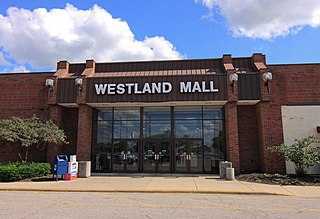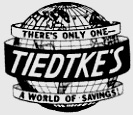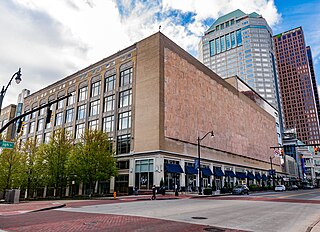
Victorian Village is a neighborhood in Columbus, Ohio, United States, north and near west of downtown. It is an established neighborhood built when a streetcar line first ran along Neil Avenue around 1900 with a fair number of established trees for an urban setting. To preserve, protect and enhance the unique architectural and historical features, the Victorian Village Historic District was established in 1973. Columbus Monthly named this neighborhood the top place to live for Arts and Entertainment, with fun right around the corner in the Short North as its neighborhood hangout.
F&R Lazarus & Company was a regional department store with its retail chain operating primarily in the U.S. Midwest, and based in Columbus, Ohio. For over 150 years, Lazarus was influential in the American retail industry, particularly during the early 20th century as a founding partner in Federated Department Stores, and continued until the nameplate was retired on March 6, 2005, in favor of Macy's.

Columbus City Center was a 1,250,000 sq ft (116,000 m2), three-level shopping mall in Columbus, Ohio. It was located in the city's downtown, near the Ohio Statehouse, next to the Ohio Theatre, and connected to the Hyatt on Capitol Square hotel. The mall closed and was demolished in 2009. The mall had a large adjacent parking structure attached that remains in use. The parking structure has been joined, directly or via bridge respectively, to two 12 story structures, 250 S. High Street and 80 on the Commons, both of which feature lower level office spaces with residential spaces on the upper floors.

Columbus Union Station was an intercity train station in Downtown Columbus, Ohio, near The Short North neighborhood. The station and its predecessors served railroad passengers in Columbus from 1851 until April 28, 1977.

The Joseph Horne Company, often referred to simply as Joseph Horne's or Horne's, was an American department store chain based in Pittsburgh, Pennsylvania. The store was one of the oldest in the country being founded on February 22, 1849, but was often overlooked as it maintained only a regional presence. The chain ceased operations in 1994 after being merged with the Lazarus division of Federated Department Stores.

Westland Mall is a demolished 860,000-square-foot (80,000 m2) shopping center located at the intersection of U.S. Route 40 and Interstate 270 on the west side of Columbus, Ohio. In November 2012, the majority of the mall closed, and the last anchor closed in 2017. A mixed use development is planned, and demolition began around August 2023.

Downtown Columbus is the central business district of Columbus, Ohio. Downtown is centered on the intersection of Broad and High Streets, and encompasses all of the area inside the Inner Belt. Downtown is home to most of the tallest buildings in Columbus.

The H. & S. Pogue Company, also known as Pogue's, was a Cincinnati, Ohio-based department store chain founded by two brothers, Henry and Samuel Pogue. Founded in 1863, it became one of the most prominent department store chains in the region, until it was sold in 1961 to Associated Dry Goods.

The Old National Centre, formerly known as the Murat Shrine Temple and the Murat Shrine Center, is located at North and New Jersey streets in Indianapolis, Indiana, and is owned by the Murat Shriners of the Ancient Arabic Order of the Nobles of the Mystic Shrine. The theater portion of the building is now known as the Murat Theatre at Old National Centre or simply the Murat Theatre and houses the oldest extant stage house in downtown Indianapolis. It is the only Shrine Center in the world with a name of French origin and is the largest Shrine Center in North America.
The culture of Columbus, Ohio, is particularly known for museums, performing arts, sporting events, seasonal fairs and festivals, and architecture of various styles from Greek Revival to modern architecture.

Tiedtke's was a former grocery and department store chain based in Toledo, Ohio. At its peak, the store, which began life as a grocery, occupied a huge building at Summit Street and Adams downtown, maintained an annex store two blocks away, and a branch store in north Toledo. It was a unique Toledo experience, and a community center. The family-founded store changed hands several times before all locations closed by 1973. The original store building was destroyed by fire two years later.

The Ohio History Center is a history museum and research center in Columbus, Ohio. It is the primary museum for Ohio's history, and is the headquarters, offices, and library of the Ohio History Connection. The building also houses Ohio's state archives, also managed by the Ohio History Connection. The museum is located at the Ohio State Fairgrounds, site of the Ohio State Fair, and a short distance north of downtown. The history center opened in 1970 as the Ohio Historical Center, moving the museum from its former site by the Ohio State University. The building was designed by Ireland & Associates in the Brutalist style. It was listed on the National Register of Historic Places along with the Ohio Village in 2023.

The Toledo and Ohio Central Railroad Station, today named Station 67, is a union meeting space and event hall located in Franklinton, near Downtown Columbus, Ohio. Built by the Toledo and Ohio Central Railroad from 1895 to 1896, it served as a passenger station until 1930. It served as an office and shelter for Volunteers of America from 1931 to 2003, and has been the headquarters of International Association of Fire Fighters Local 67, a firefighters' union, since 2007. The building was placed on the National Register of Historic Places in 1973. During its history, the building has experienced fires and floods, though its relatively few owners have each made repairs and renovations to preserve the building's integrity. The building is the last remaining train station in Columbus.
Albert C. Haft was a wrestler, wrestling and boxing promoter and wrestling trainer who was a prominent promoter in the United States from the late 1910s until the 1960s, running his operations primarily from Columbus, Ohio. He founded the Midwest Wrestling Alliance and was one of the founding members of the National Wrestling Alliance in 1948.

The Lazarus Building is a commercial building in Downtown Columbus, Ohio. It was the flagship store of the F&R Lazarus & Company, a department store founded nearby in 1851. The building, completed in 1909, housed the Lazarus department store until 2004, one year before its brand was retired. The building currently houses numerous state and county offices, the Ohio State University Urban Arts Space, and restaurants and a bank branch in its storefronts on High Street.

The 1887 Franklin County Courthouse was the second permanent courthouse of Franklin County, Ohio. The building, located in the county seat of Columbus, stood from 1887 to 1974. It replaced a smaller courthouse on the site, extant from 1840 to c. 1884. The 1887 courthouse deteriorated over several decades, and the site was eventually replaced with Dorrian Commons Park, open from 1976 to 2018; the court moved to a new building nearby. As of 2020, the site is planned to once again hold the county's Municipal Court building.

The Columbus Board of Trade Building was a historic building on Capitol Square in Downtown Columbus, Ohio. The building was built in 1889 for the present-day Columbus Chamber of Commerce, and was designed by Elah Terrell and Joseph W. Yost. It became vacant in 1964 and was demolished five years later. The Rhodes State Office Tower sits on the site today.

The 1840 Franklin County Courthouse was the first permanent courthouse of Franklin County, Ohio in the United States. The building, located in the county seat of Columbus, stood from 1840 to 1884. The building was replaced with another county courthouse in 1887, and after its demise, that courthouse was replaced with Dorrian Commons Park, open from 1976 to 2018; the courthouse moved to a new building nearby. The site is now planned to host the Franklin County Municipal Court.

The Park Hotel was a hotel in Columbus, Ohio. It was later in its history known successively as the Northern Hotel, the Railway Y.M.C.A., and as the Goodale Hotel. The building stood at the northwest corner of North High Street and Goodale Street.

171-191 South High Street is a pair of historic buildings in Downtown Columbus, Ohio. The commercial structures have seen a wide variety of retail and service uses through the 20th century, including shoe stores, groceries, opticians, hatters, jewelers, a liquor store, and a car dealership. Both exhibit early 20th century façades; 185-191 South High was constructed in 1906, while 171-177 South High was constructed sometime in the 19th century and was remodeled in the second decade of the 20th century. The latter building was once part of the Lazarus Block, holding the original Lazarus department store. The store grew to encompass a group of seven buildings on the site until it moved to the Lazarus Building in 1909. The same building was again noted in the 1930s, for housing the first Kroger store in Downtown Columbus, which was considered the first supermarket in the city. The buildings, the nearby Ohio National Bank building, and a garage building were sold to a development company in 2023. The developer plans to renovate the bank building and demolish all other structures on the block. In June 2023 the buildings were placed on the Columbus Landmarks Foundation's Most Endangered List.






















